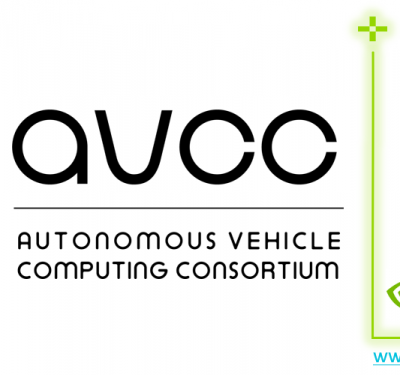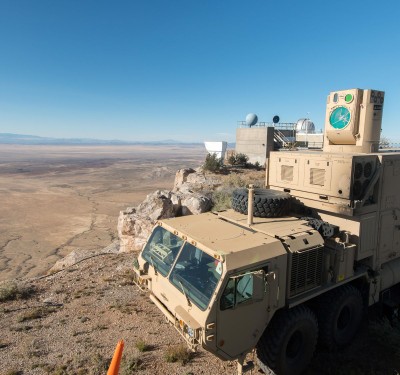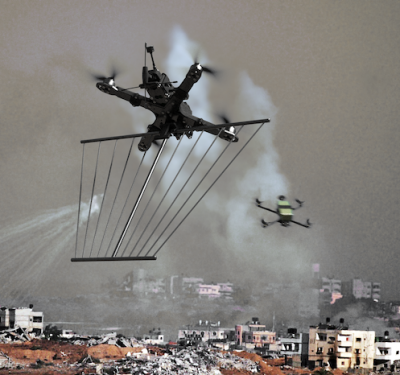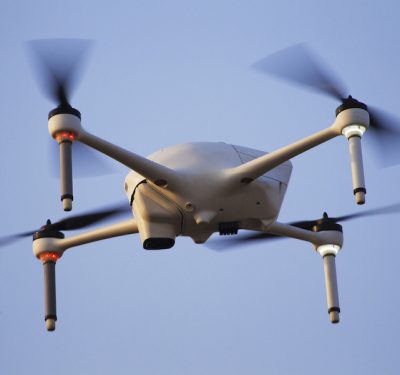The Virginia team, led by the Innovation and Entrepreneurship Investment Authority, plans to develop safe, effective procedures that can be put into place for beyond visual line of sight (BVLOS) flights—engaging community members throughout the process.

AeroEnvironment Puma being hand launched to conduct BVLOS inspections on a Dominion Energy 230kV transmission in Buckingham County, VA.
For years, the Virginia Tech Mid-Atlantic Aviation Partnership (MAAP) drone test site has focused its research on proving what unmanned aircraft systems (UAS) can do and how the technology can benefit a variety of industries. They’ll continue that work as they spearhead Virginia’s Integration Pilot Program (IPP) but with a slightly different twist.
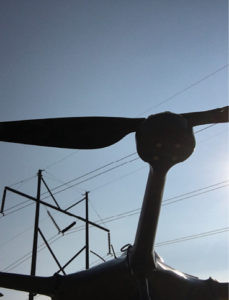
UAV America’s Eagle Drone waiting to launch to do BVLOS inspections on a Dominion Energy transmission line in Buckingham, VA.
Rather than concentrating on proof of concept flights, MAAP and the partners who are part of the Innovation and Entrepreneurship
Investment Authority team will shift their attention to community engagement as well as developing procedures to safely integrate drones into the National Airspace, with a focus on beyond visual line of sight (BVLOS) flights.
To start, they’ll work with Project Wing to investigate package delivery, State Farm to look at how flying drones BVLOS can speed up damage assessment after natural events, and Dominion Energy to determine the best way to incorporate BVLOS flights for infrastructure inspection. MAAP has a history with each company, and began working on all three projects before they knew they’d be one of the 10 teams selected for the program, MAAP Director Mark Blanks said.
“There’s a lot that we’ve already started, though there will be some changes in each project under IPP. We’ve been working in all these areas for quite a long time and now we’re scoping out what we want to accomplish over the next few years and determine if it makes sense to scale our approach or to do it all at once in different areas,” Blanks said. “We’ll focus more on community outreach and engagement and getting feedback from localities. How that rolls out is still to be determined at this point.”
GETTING COMMUNITIES INVOLVED
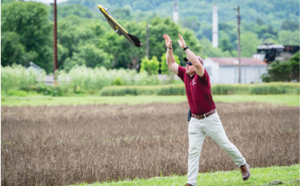
Thomas Jones, a program manager with the Virginia Tech Mid-Atlantic Aviation Partnership, launches a lightweight drone during tests with IPP partner State Farm; the insurance giant is exploring how drones might speed up claim response times after natural disasters.
One of the goals for the Virginia team is to move beyond the testing environment and to start completing more flights in real-world scenarios, Blanks said. This is the best way to introduce the public to drones and to prove the good they can do. Though the details on how this will work aren’t clear yet, community members will have a chance to offer feedback to the team as well as to bring up any concerns they have as the projects progress.
While the type of engagement will largely depend on the project, Blanks said, the team will likely first talk with key community stakeholders about what they can expect during testing. From there, public meetings will be held. Community members also will be able to send emails through the team website.
The feedback received will tell Blanks and partners how the technology truly impacts community members, and if it’s something they see value in pursuing.
“The main goal is to showcase this can be done on a broader scale,” Blanks said. “It’s one thing to operate in a test environment, it’s
another to do it in the real world and over long distances. The technological evolvement has been happening for years. The focus now is what changes when communities get involved. Our hope is we can address community concerns through education and transparency.”
DEVELOPING BVLOS PROCEDURES
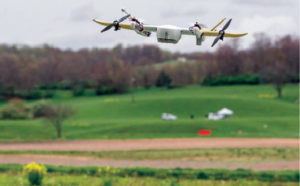
IPP Partner Wing uses a UAS with 12 rotors for vertical lift and two forward-facing propellers that enable it to fly longer distances.
Dominion Energy first began working with MAAP in 2014 when they needed help obtaining a Certificate of Waiver or Authorization (COA) from the Federal Aviation Administration (FAA) to fly utility infrastructure inspections. The company recently completed four such campaigns on extended line of sight flights with both multi-rotor and fixed-wing systems, said Steve Eisenrauch, Dominion Energy’s manager of electric transmission forestry and line services. Those tests included using chase planes, daisy chain observers and satellite communications.
As part of the Virginia IPP team, Eisenrauch expects Dominion to gain faster access to Part 107 waivers for the more advanced flights they’d like to incorporate into their operations, he said. He’s hoping to begin flights in late September or early October, but noted the tests will be focused on developing procedures for BVLOS flights. Dominion is most interested in making BVLOS inspections and patrols a routine part of what they do, as well as deploying drones BVLOS for storm restoration as needed.
“What we’re after is not so much proof of concept anymore,” he said. “We want to actually get out there and start developing our procedures to make this operational. It goes from the proof of concept perspective to how do we make this operational—how are we able to fly these systems on a regular basis. That’s the difference you’re going to see in the testing.”
While Dominion’s main focus is BVLOS flights, that doesn’t mean they’re not interested in other advanced operations, Eisenrauch said. He sees the potential of deploying drones equipped with infrared cameras at night for storm restoration and patrol, for example. Overall, they want to find advanced ways to deploy UAS that will benefit utility companies as well as their customers.
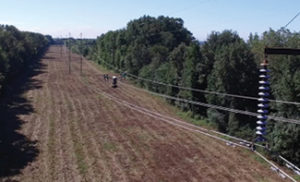
DJI Inspire performing line inspections on a Dominion Energy transmission line in Henrico County, VA.
“Beyond just being able to fly our systems operationally, we want to leverage this for our peers and other electric utilities,” Eisenrauch said. “What’s nice about our industry is we have defined service territories so we’re not in competition with one another. We can openly share a lot of our learnings so other companies can do the same thing we’re able to do.”
Last year, State Farm began working with MAAP to obtain waivers for BVLOS operations as well as flights over people, said Todd Binion, P&C Claims Staff Consultant at State Farm. They began a project that focused on field testing to support waivers for these operations, and because they had already formed a partnership with the test site, it just made sense for State Farm to join the Virginia IPP application.
They’ll continue to expand on the work they’ve already done, which involved scoping out the concept of operations, thinking through documentation and accessing risk, Binion said.
“We’re identifying some of the potential challenges involved with flying BVLOS and developing test cards that address those scenarios and offer potential mitigations that would result in safe operations of the drone and de-confliction with manned aircraft or other similar concerns,” he said. “We’ll then test these mitigations and validate the most efficient means for managing risk for those types of operations. That results in risk-based safety case development.”
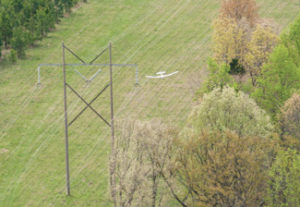
AeroVironment Puma performing BVLOS inspections on a Dominion Energy 230kV transmission line in Buckingham County, VA.
Once safety cases are developed for these advanced uses, they’ll be rolled into waiver applications submitted to the FAA, Binion said.
State Farm already deploys drones to assess roof damage after storms, which helps speed up the claims process so customers get paid faster, Binion said. These assessments are completed one house at a time, which is effective in most situations, but during a catastrophe that effects a large number of people, it would be better to deploy multiple drones at once to assess damage in certain neighborhoods and towns. Based on what’s found in the aerial imagery, State Farm could then quickly determine which policy holders were impacted most and begin providing claim services. That, of course, requires BVLOS operations and flights over people.
“What we see as an opportunity for using aerial imagery, particularly from a drone, is the ability to enhance our response beyond what we’re able to do today,” Binion said. “We don’t see drones as the only option after a storm, but it’s a great addition to the menu of items we have available to use depending on the scenario. There may be scenarios where flying beyond visual line of sight is not feasible or useful

A fixed-wing drone flies along a powerline corridor near Farmville, Virginia in 2017, as part of tests that assessed communications performance during longer-range flights
and other times where it is.”
THE CHALLENGES
Safely incorporating advanced drone operations into the National Airspace is a huge challenge in and of itself, which is why the IPP teams were created in the first place, Binion said. For State Farm, one of the most difficult tasks will be completing the legwork to truly understand what the operational and technical challenges are, and what capabilities they can unlock to better serve their customers.
From the IPP standpoint, there are a wide range of users—both in the program and throughout the drone industry—who have different objectives and needs. State Farm is focused on roof inspections, while others are looking into delivering medical devices or controlling mosquitos, to name just a few uses the teams are exploring. While no use case is more important than another, the variety that exists presents a challenge.
“This isn’t something that’s going to be solved on the first day. It wasn’t solved with Part 107 and it won’t be solved in 2019,” Binion said. “But we can get these first projects off the ground and iterate through waiver requests. There are a lot of good re
asons to use drones beyond visual line of sight but there are a lot of challenges to work through to prove we can do that safely. That’s what this is all about. The project is setting the foundation to help us understand what works and what doesn’t. Hopefully, that will help the FAA move forward with continuing to streamline how they approach these types of operations.”
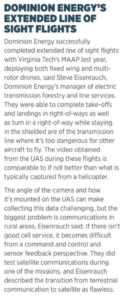
The projects are also pushing the limits of BVLOS, Eisenrauch said, and companies like Dominion Energy need to make sure the technology is capable of performing advanced missions safely and efficiently. For example,
communicating in rural communities where cell service is sparse is often difficult, and detect and avoid technology still isn’t where it needs to be for many of the projects the teams are pursuing.
Remote ID is another piece of the puzzle, Blanks said, as is gauging just how the community feels about drones.
“Do communities really want this? Does the public see the value in this or do they just have concerns?,” Blanks said. “The example I like to use is most people wouldn’t have walked around with a location device on them 24/7 10 years ago, but now everyone has a smart phone because they perceive a value beyond the perceived privacy concerns. The value proposition of drones to communities is still a big question mark. Our job is to make the interaction between the public and drones as positive and productive as possible.”


